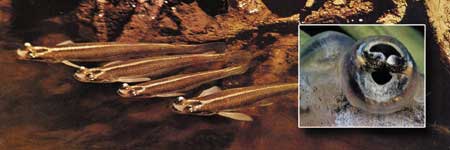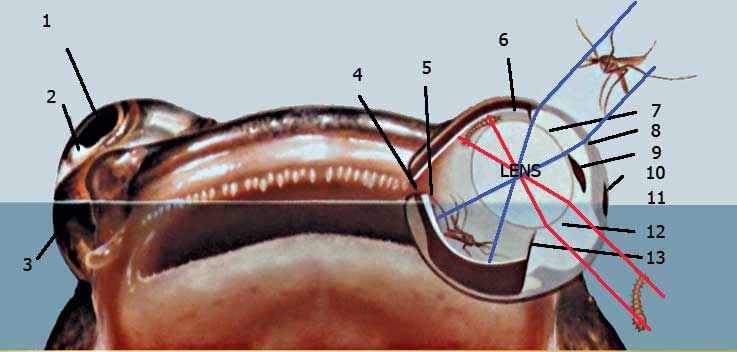Bigotry: The Dark Danger
Engineering In Nature

DOWNLOAD THE BOOK
CHAPTERS OF THE BOOK
< <
4 / total: 7
Physical Engineers With an Expert Knowledge of Optics
How does a tiny ant find its way in the desert wastes? How do butterflies regulate their body temperatures? How does a fish see above the surface of the water? In addition, how does it go even further and calculate the angle of refraction in such a way as to catch an insect above the water's surface? One common feature of all these creatures is that their behavior requires expertise in the field of optics. As we'll be seeing in some detail, some butterfly species warm their bodies by using the same rules of optics employed by physicists. Another example is the four-eyed fish anableps, whose optic design gives it an advantage both in an atmospheric and an aquatic environment. When we examine these systems and intelligent behaviors, all the products of a special design, it emerges that by itself, a butterfly or an ant can't possibly establish such systems in its body much less know how to use them. All living things emerged in a moment, together with all the features they possess and the knowledge of how to employ them. God has created them all in the most beautiful form. Butterflies that Know the Laws of Optics
Physicists use three basic principles in optics: A surface warms up more as the light rays striking it approach 90 degrees. If two surfaces receive light at the same angle, the darker one will warm up more. When light strikes a reflective surface, it's reflected at the same angle as it arrived. Although students of physics know these laws, many people today are unaware of their effects on daily life and the purposes they serve. What is surprising, however, is that there are other creatures that put these principles to good use. In their daily lives, butterflies make use of these laws, of which many humans are ignorant. For example, the Colias butterfly is unable to fly when its body temperature drops below 28oC (83oF). In that event, it immediately spreads out its wings and, turning its back to the Sun, adjusts them perpendicular to its rays. When its internal temperature rises to a sufficient40oC (104oF), its turns around 90 degrees, which minimizes the warming effect of the Sun's rays, and the butterfly's body temperature starts to fall. On its wings, this species of butterfly has black spots that also serve to collect heat in the butterfly's body.32 Significantly, these spots are located near those regions of the body which most need to be warmed, so that the heat is transferred over a shorter distance.
These butterflies have certainly received no training in physics or optics. They are unaware of the laws of physics and of the angle at which solar rays can be most productive. It is God, the protector and observer of all, Who inspires these creatures with what they need to do to warm themselves in the most productive manner. It is revealed in a verse that Our Lord has dominion over all: Everything in the heavens and everything in the Earth belongs to Him. God is the Rich Beyond Need, the Praiseworthy. (Surat al-Hajj: 64)
Magnificent Optical Design in the Four-Eyed FishWhen swimming underwater, everything around you appears blurred. That's because water represents a very different environment for our eyes, which have been created to be able see in an atmospheric environment. Accordingly, a fish taken out of its normal habitat into an atmospheric environment might also be expected to see everything as blurred. However, one species of fish, which lives in rivers and lakes from Southern Mexico to northern South America, can see very well both in the water and above. This is the anableps, better known as the four-eyed fish. Not only able to see very clearly outside the water, this fish can even focus on objects in the air. The anableps actually has only two eyes, but each is divided horizontally; that is, each eye has two separate optical systems, each with its own focal length. This flawless design explains why the anableps see two different images at the same time. When swimming slightly beneath the surface its pupils remain above the surface of the water and constantly scan the air. In this way the fish is able to feed on flying creatures or flee swimming ones. The two separate focal points in the fish's eye let it receive two images at the same time. A spotted band of tissue containing pigment and each of the visible irises divide each eye into two halves at the water line, and these form two pupils, one above the water and the other beneath it. Looked at from above, the irises resemble fingers floating in the air inside protuberant eyes.34 The four-eyed fish is able to leap into the air to catch insects and to dive into the water to hunt swimming creatures. However, it mainly catches crustaceans moving in the shallow water near the shore, algae, or insects trapped on the water's surface. Scientists have established that the fish pays more attention to the air, where it can perceive objects that are smaller and more distant. Even so, it frequently dives down into the water to feed or to escape predators.
• How Did This System Come Into Being? It's no doubt that it is impossible for a fish to design two different visual optical systems for itself, according to the different optical properties of air and water, and then to install both systems so that they can work in harmony within a single eye. Could its eyes have come into being by random processes, as the theory of evolution maintains? In other words, could this optical design—the likes of which is found nowhere else—have appeared by chance mutation in one individual's eyes, and then have been transmitted to subsequent generations? Of course not. Complex structures such as eyes depend on a great many inter-related components working together. The absence of or a defect in any one will mean the eye serves no purpose at all. Systems like this are known as "irreducibly complex." For example, the human eye cannot be reduced to any simpler form, since without every single one of its features, it can serve no function at all. This is further proof that the eye couldn't have "evolved" in stages over the course of time. As Darwin himself admitted, "If it could be demonstrated that any complex organ existed, which could not possibly have been formed by numerous, successive, slight modifications, my theory would absolutely break down."35 This single example undermines the very foundations of his theory of evolution. Darwin was aware that he faced a grave dilemma with regard to the "evolution of the eye." Indeed, he confessed this in the chapter of his book called Difficulties on Theory. The American physicist H. S. Lipson, who read Darwin's book, made the following comment about these "difficulties" of Darwin's: On reading The Origin of Species, I found that Darwin was much less sure himself than he is often represented to be; the chapter entitled "Difficulties of the Theory" for example, shows considerable self-doubt. As a physicist, I was particularly intrigued by his comments on how the eye would have arisen.36 Since evolutionists can't account for the emergence of a single eye, they obviously can offer no explanation of the origin of the four-eyed fish, which can see as well as a human being above the water, but as well as a fish underneath it. The four-eyed fish, has been created by God, with an extraordinary system, using no previous models, and utterly flawlessly. Evolutionists refuse to see this obvious truth and still insist on believing in nonsense, but everyone else should determinedly avoid falling into the same error. This deep lack of understanding is given to them in return for their rejection of the existence of God. In one verse God reveals: Do not be like those who forgot God so He made them forget themselves. Such people are the deviators. (Surat al-Hashr: 19) Since the refraction indices of water and the eye's cornea are nearly the same, light reflected from underwater objects passes directly through the cornea and is focused in the lens, which has a higher index. Air, on the other hand, has a lower refractive index than the cornea, for which reason the light is refracted twice. The anableps sees both images clearly by using its flawless, egg-like lenses. The section of the lens at the same level as the pupil has been given a spherical shape, just like a fish's eye. A swimming insect larva can thus be focused onto the retina. The less rounded upper part, on the other hand, more closely resembles the human eye and compensates for the two refractions that take place when looking at objects in the air. The fish can thus see even a mosquito perfectly clearly. This perfect design is just one of the countless examples of God's incomparable creative artistry.
The Compass in the Ant's EyeWe need a map to shows us where we are, and a compass to tell us which direction to take. But the black desert ant, which lives along the Mediterranean coast of Tunisia Mahares, can find its way without using either device. When the Sun rises, the ant leaves the nest to search for food in the desert sands, whose temperatures can rise as high as 70 °C (158°F). The ant follows a meandering course in an area extending up to 200 meters (650 feet) from its nest, frequently stopping and turning around. Yet despite all these complex zigzags, upon finding food, it follows a straight line back to its nest. Compared to its own size, this journey the ant undertakes is equivalent to a human being walking 35 to 40 km (21 to 24 miles) in the desert and then returning to his starting point, without neither map nor compass.37 The magnitude of this accomplishment can be better understood by bearing in mind the scarcity of signs in the desert to help the ant find its way. It would be yet another miracle for the ant to remember the landmarks it saw on its wanderings and then find its way by searching them out. Yet the direction-finding system placed in its eyes by God is far superior to either map or compass. The desert ant is able to polarize light—one feature lacking in the human eye. During this process it perceives certain rays that are invisible to us and, using them, can distinguish north and south every time it looks around. It thus always estimates the direction in which its nest lies and has no difficulty in returning to it. How can one account for an ant knowing about polarized light, something that humans discovered only recently, and using it like a compass? It is of course impossible for the ant to know all of this by itself. Again, it's impossible to account for this ant's complex eye structure in terms of random coincidences. Ever since their first days on Earth, all desert ants have possessed eyes with exactly the same properties—the gift of their Creator, Who created us and all other living things. In one verse it is revealed: He is Lord of the heavens and the Earth and everything in between them, so worship Him and persevere in His worship. Do you know of any other with His Name? (Surah Maryam: 65)
Footnotes33. "Gunes Kolektoru Gibi Kelebek" (The Solar Collector Butterfly), Bilim ve Teknik, April 1991, p. 49. 34. Paul A. Zahl, "The Four-eyed Fish Sees All", National Geographic, March 1978, vol.137, No.1, pp. 390-395. 35. Charles Darwin, The Origin of Species: A Fascimile of the First Edition, Harvard University Press, 1964, p.189 36. H. S. Lipson, "A Physicist's View of Darwin's Theory", Evolution Trends in Plants, vol. 2, no. 1, 1988, p. 6. 37. "Hayvanlarda yon bulma" (Direction Location in Animals), Bilim ve Teknik, May 1995, no.330, p. 69.
|
|||||||||||||||||||||||||||||||||
4 / total 7
You can read Harun Yahya's book Engineering In Nature online, share it on social networks such as Facebook and Twitter, download it to your computer, use it in your homework and theses, and publish, copy or reproduce it on your own web sites or blogs without paying any copyright fee, so long as you acknowledge this site as the reference.









